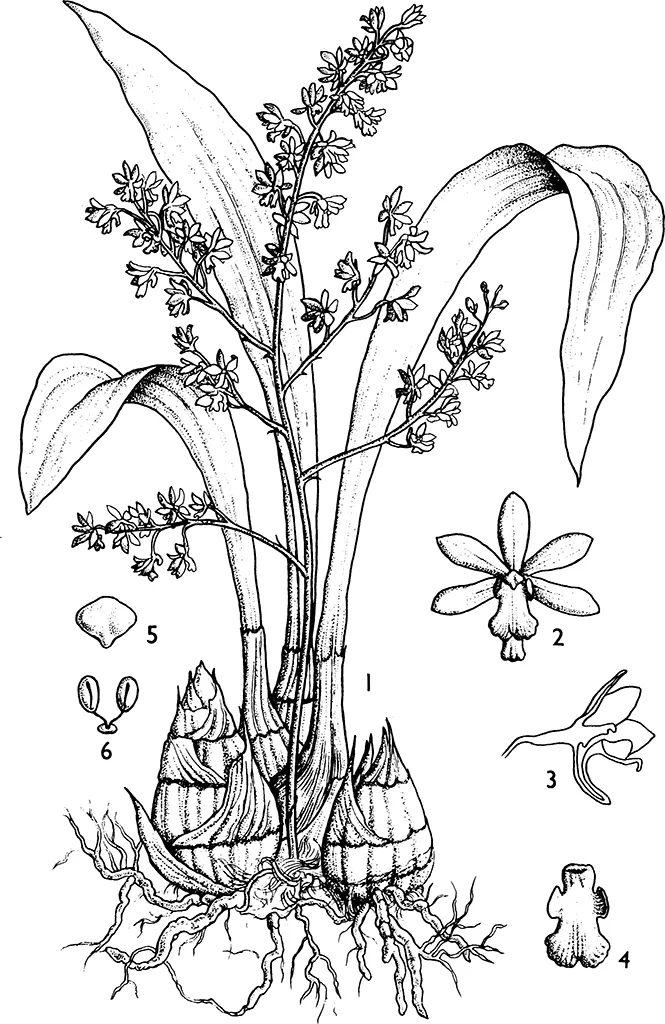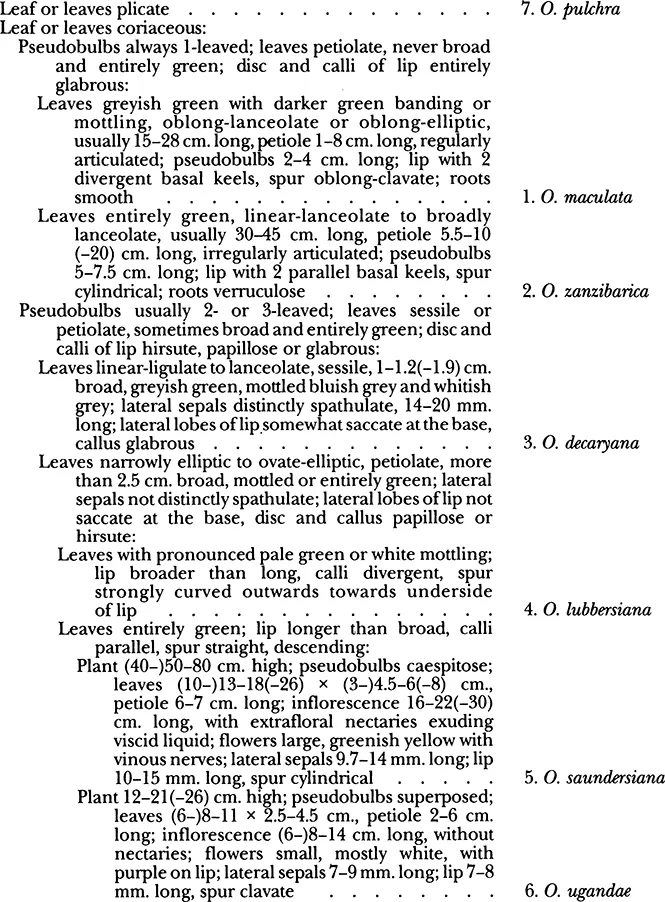
eBook - ePub
Flora of Tropical East Africa
Orchidaceae (Part 3)
P. Cribb
This is a test
Share book
- 103 pages
- English
- ePUB (mobile friendly)
- Available on iOS & Android
eBook - ePub
Flora of Tropical East Africa
Orchidaceae (Part 3)
P. Cribb
Book details
Book preview
Table of contents
Citations
About This Book
First published in 1989. This is Part 3 of a reference guide of the Orchidaceae family of plants as noted in the tropics of East Africa. It begins from the genera of Epidenreae, including sketches, family classifications, descriptions and locations.
Frequently asked questions
How do I cancel my subscription?
Can/how do I download books?
At the moment all of our mobile-responsive ePub books are available to download via the app. Most of our PDFs are also available to download and we're working on making the final remaining ones downloadable now. Learn more here.
What is the difference between the pricing plans?
Both plans give you full access to the library and all of Perlego’s features. The only differences are the price and subscription period: With the annual plan you’ll save around 30% compared to 12 months on the monthly plan.
What is Perlego?
We are an online textbook subscription service, where you can get access to an entire online library for less than the price of a single book per month. With over 1 million books across 1000+ topics, we’ve got you covered! Learn more here.
Do you support text-to-speech?
Look out for the read-aloud symbol on your next book to see if you can listen to it. The read-aloud tool reads text aloud for you, highlighting the text as it is being read. You can pause it, speed it up and slow it down. Learn more here.
Is Flora of Tropical East Africa an online PDF/ePUB?
Yes, you can access Flora of Tropical East Africa by P. Cribb in PDF and/or ePUB format, as well as other popular books in Biological Sciences & Botany. We have over one million books available in our catalogue for you to explore.
Information
FLORA OF TROPICAL EAST AFRICA
ORCHIDACEAE (Part 3)
P.J. CRIBB *
III EPIDENDREAE (coninued)
A key to the tribe Epidendreae is given in Part 2 of this account published in 1984. However, as this part will undoubtedly be used on occasion by those without immediate access to earlier parts of the Flora, a key to the genera of the Epidendreae included in this part is provided here.
KEY TO THE GENERA OF THE EPIDENDREAE IN PART 3
| 1. Plants epiphytic or lithophytic; some of the roots aerial, ascending around the bases of the pseudobulbs, tapering to fine points .......... | 43. Graphorkis |
| Plants terrestrial .............. | ........2 |
| 2. Lip 4-lobed, the lobes subequal; spur subglobose to cylindric ............... | 44. Oeceoclades |
| Lip 3-lobed or entire; spur absent, saccate, clavate or cylindrical............... | ........3 |
| 3. Spur absent; lip deeply 3-lobed at the base with the side lobes almost free to the base; column very short, biauriculate, lacking a foot......... | 46. Pteroglossaspis |
| Spur present, saccate, clavate or cylindrical, or rarely absent; lip 3-lobed in the middle or apical half with the side lobes united to the rest of the lip for most of their length; column usually slender, elongate, lacking auricles, with a short to long foot....... | 45. Eulophia |
43. Graphorkis**
Thou. in Nouv. Bull. Sci. Soc. Philom. Paris 1: 318 (1809)
Epiphytic, sympodial herbs. Pseudobulbs clustered, conical-ovoid to cylindrical-fusiform, with several nodes, partially covered by fibrous persistent leaf-bases; roots of two types, those attached to substrate and those that are aerial, which are narrow, clustered and vertical. Leaves narrowly elliptic, acute to acuminate, plicate, petiolate. Inflorescence proteranthous, erect, paniculate, many-flowered; lowermost bracts conspicuous, uppermost bracts inconspicuous. Flowers resupinate, small to medium-sized, yellow, marked brown or purple. Sepals and petals free, spreading. Sepals spathulate to oblong-elliptic, subacute. Petals narrowly elliptic. Lip 3-lobed, spurred at base; disc with 2 keels; mid-lobe crenulate to bifid; spur often bent forward. Column with hirsute basal auricles; rostellum elongate; pollinia 2, waxy, sessile, attached to a solitary viscidium.
Five species in Madagascar and the Mascarene Is., and a single species in tropical Africa.

Fig. 89 Graphorkis Lurjda— 1, habit, × ⅔; 2, flower, × 3⅔ 3, longitudinal section of flower, × 2⅔; 4, lip, × 9⅓; 5, anther, × 14; 6, pollinarium, × 14; 1, from Brown 361, 2–6, from Eggeling 5183. Drawn by Cherry Ann Lavrih.
G. lurida (Sw.) 0. Kuntze, Rev. Gen. PL 2: 662 (1891); Summerh. in K.B. 8: 161 (1953); Piers, Orch. E. Afr., ed. 2: 191 (1968); Summerh. in F.W.T.A., ed. 2, 3: 251 (1968); Williamson, Orch. SC. Afr.: 150 (1977). Type: Sierra Leone, without exact locality, Afzelius (UPS, holo.)
An erect epiphytic herb. Pseudobulbs cylindrical-fusiform or conical-ovoid, yellowish, with 3–5 nodes, 3–9 cm. long, 1–3 cm. broad, 4–6-leaved. Leaves narrowly elliptic, acute to acuminate, plicate, articulated at a persistent sheathing base, thin-textured; median and some secondary nerves prominent and hard, partially remaining as sharp, rigid thorns after lamina is shed; sheaths blackish brown along margins and at base, becoming scarious and fibrous, 2–3(–5) cm. long; lamina, including petiole, 20–40 cm. long, 1.5–3.5(–4) cm. broad. Inflorescence erect, paniculate, 15–50 cm. long, appearing from base of pseudobulbs; branches spreading, 3–22 cm. long, many-flowered; sterile bracts 3–4, remote, ovate-elliptic, obtuse to acute, amplexicaul, 1.5–4 cm. long; bracts subtending branches ovate-elliptic or narrowly elliptic, acute, 0.8–2.5 cm. long; fertile bracts triangular-ovate, acute, 0.1–0.3 cm. long. Flowers with sepals purple or brown on the outside, pale green inside, petals pale green or cream flushed purple or brown, lip with pale greenish yellow side lobes and deep yellow mid-lobe. Pedicel with ovary slender, 10–15 mm. long. Sepals spathulate-oblong, obtuse, 5–6.5 mm. long, 1.5–2 mm. broad. Petals elliptic, obtuse, 4–6 mm. long, 2.5–3 mm. broad. Lip 3-lobed, 5–6 mm. long, 3 mm. broad; mid-lobe retuse to bifid; side lobes oblong, obtuse, erect; disc with 2 fleshy keels; spur cylindrical, obtuse, sharply bent forward, 3–4 mm. long. Column erect, oblong, biauriculate at base, 3 mm. long; anther ovate. Pl. 1. Fig. 89.
UGANDA. Bunyoro District: Busingiro, 1944, Eggeling 456!; Busoga District: between Kenya border andjinja, 1968, Piers!; Mengo District: Entebbe, Nov. 1905, E. Brown 361!
TANZANIA. Ufipa District: near Lake Tanganyika, Feb. 1976, C. Owens in Cribb!
DISTR. U 2–4; T 4; Senegal, Guinea-Bissau, Guinée, Sierra Leone, Liberia, Ivory Coast, Ghana, Togo, Nigeria, Bioko [Fernando Po], Cameroon, Equatorial Guinea, Gabon, Zaire, Burundi
HAB. In forest, often epiphytic on palms, particularly Hyphaene; 1050–1300 m.
Syn. Limodorum luridum Sw. in Schrad., Neues Journ. Bot. 1: 87 (1805) Eulophia lurida (Sw.) Lindl., Gen. Sp. Orch. Pl.: 182 (1833); Rolfe in F.T.A. 7: 55 (1897) Eulophiopsis lunda (Sw.) Schltr., Die Orchideen: 348 (1914); Summerh. in F.W.T.A. 2:446 (1936); Moreau in Journ. E. Afr. Nat. Hist. Soc. 17: 27 (1943); Piers, Orch. E. Afr: 66 (1959)
44. Oeceoclades*
Lindl. in Bot. Reg. 18, sub t. 1522 (1832)
Aeceoclades Duchartre in Orbigny, Diet. 9: 170 (1849)
Eulophidium Pfitz., Entw. Natur. Anordn. Orch.: 87–89 (1887)
Eulophidium Pfitz., Entw. Natur. Anordn. Orch.: 87–89 (1887)
Terrestrial, rarely epiphytic herbs. Pseudobulbs close together, usually ovoid to fusiform, ± approximate, usually heteroblastic (with only one internode elongated, the remaining basal ones very short), apex 1–3-leaved, up to 15 cm. long and 3 cm. broad, but often narrower. Leaves usually with duplicate vernation, coriaceous, conduplicate, often variegated, usually petiolate, the petiole articulate some distance above the base and sometimes above the middle, the line of articulation consisting of a number of irregular blunt or acute teeth or occasionally ± regular. Inflorescences arising from the base of the pseudobulb, often exceeding the leaves, simply racemose or frequently paniculate; bracts inconspicuous, rarely with a basal extrafloral nectary. Flowers resupinate, rather small, thin in texture. Sepals and petals free, variously spreading, similar, the petals usually slightly shorter and broader. Lip decurved, spurred, 3- or apparently 4-lobed; side lobes erect; mid-lobe usually lobulate or emarginate; disc either with 2 approximate, quadrate or triangular calli at the spur entrance or with 3 variously thickened, parallel ridges which together with the lateral nerves are sparsely but distinctly papillose or hirsute. Column erect, short, oblique at the base or with a short foot; anther cucullate or cristate; pollinia 2, ovoid or pyriform, on a short or rudimentary stipe; viscidium large; stigmata confluent; rostellum short.
A genus of 31 species native to the tropics and subtropics of Africa, Madagascar, the Mascarene Is., Seychelles, SE. Asia, Australia, the Pacific Is., the West Indies, the Bahamas and South America.
Lindley established the genus Oeceoclades in 1832 and it is lectotypified by Angraecum maculatum Lindl. In 1887 Pfitzer established Eulophidium which he also based on Angraecum maculatum Lindl. while fully aware of Lindle’s suggestion that the name Oeceoclades be applied only to 0. maculata. Since both genera, Oceoclades Lindl. and Eulophidium Pfitz., are based on the same type, Angraecum maculatum Lindl., Oeceoclades was reinstated by Garay & Taylor (1976) because of the rules of priority.

1. O. maculata (Lindl.) Lindl, Gen. Sp. Orch. PL: 237 (1833); Summerh. in B.J.B.B. 27: 397 (1957); Garay & Taylor in Bot. Mus. Leafl. Harv. Univ. 24: 266 (1976). Type: Brazil, without precise locality, cultivated Loddiges 34.10.16 (BM, holo.)
A terrestrial or epiphytic herb (16–)28–30(–40) cm. high, entirely glabrous; roots stout, verruculose. Pseudobulbs congested, ovoid, ovoid-oblong or stout and cylindrical, (2–) 2.5–4 cm. long, 1-leaved, concealed and exceeded by several pale brown, ovate-elliptic, acute, imbricate, evanescent cataphylls. Leaves oblong-oblanceolate or oblong-elliptic, acute, duplicate, particularly towards base; lamina (10–)15–28(–40) cm. long, 2.5–4.5(–6) cm. broad, with the median nerve prominent on lower surface, greyish green, with darker green transverse, irregular banding or mottling; petiole 1–8 cm., regularly articulate. Inflorescence simple or with 1 or 2 short branches, 5–12(–20) cm. long, 3–4 cm. broad, erect, lax, 6–12(–20)-flowered, sometimes branched at base; bracts lanceolate, acuminate, scarious, lowermost to 17 mm. long, uppermost to 4 mm. long. Flowers porrect; sepals and petals translucent greenish white or pinkish green, sometimes straw-coloured; lip greenish white or cream with rose-pink nerves on the side lobes and 2 rose-pink blotches at the base of the mid-lobe; calli white; spur greenish white, flushed rose-pink or brownish green; column cream; pedicel and ovary slender, 10–13(–15) mm. long. Dorsal sepal linear-ligulate or linear-elliptic, obtuse to acute, 3-nerved, incurved, (8–)10–12(–13) mm. long, 2–3.2 mm. broad; lateral sepals linear-ligulate or narrowly oblanceolate-oblong, falcate, obtuse to acute, 3-nerved, (6–)7.5–9(–ll) mm. long, 2–3.3(–4.6) mm. broad. Petals oblong-elliptic, oblique, acute, 3-nerved, broader than sepals, (8.3–) 10—11.2 mm. long, (2–)3.3–4.6 mm. broad. Lip projected forwards, articulated at the base, distinctly 3-lobed, subquadrate in outline, glabrous, 7–9 mm. long; mid-lobe broadly obovate or reniform, abruptly and shortly clawed at the base, lobulate, retuse or ± truncate, longer than side lobes, 3.5–4.2 mm. long, (6–)7–8(–10) mm. broad; side lobes semiobovate, rounded, not saccate at the base, erect, somewhat incurved, nerves not prominent, shorter than mid-lobe; disc with 2 approximate, obliquely semiobovate, divergent basal keels, glabrous; spur short, stout, oblong-clavate, rounded, straight, 4–5 mm. long. Column erect, oblong, oblique at base or with a short foot, 4–5 mm. long, 2 mm. broad; anther oblong, ± 2.2 mm. long.
UGANDA. Kigezi District: Impenetrable Forest, 1945, C.G van Somerenl; Busoga District: Igwe, 26 May 1951, GK Wood 265!
TANZANIA. Ulanga District: Mahenge, Mbangala, 20 Feb. 1932, Schlieben 1803!; Rungwe District: Mbaka Kilambo, 6 Mar. 1913, Stolz 1909!; Zanzibar I., Mvuleni, May 1933, Vaughan 2110!; Pemba I., Micheweni, 20 Apr. 1957, Tremlett 2!
DISTR. U 2, 3; T 6, 7; Z; P; Senegal, Guinea-Bissau, Sierra Leone, Liberia, Ghana, Togo, Nigeria, São Tomé, Gabon, Zaire, Congo-Brazzaville, Burun...